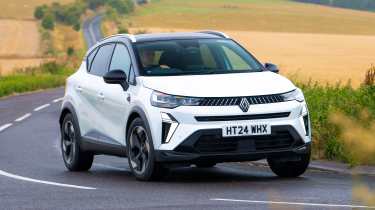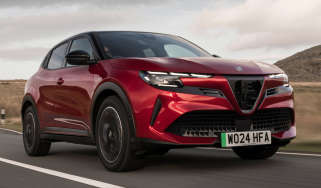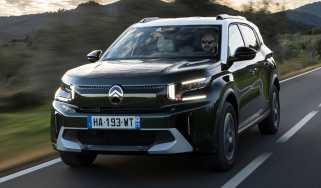Renault Captur review – Engines, drive & performance
"Supple suspension serves up a relaxing ride, but the petrol model feels underpowered"
Before the facelift we found the Renault Captur’s suspension setup to be very soft and it was clear the focus was on a supple, relaxed ride. For a more engaging and sporty experience, you’d be better served by the Ford Puma. That’s still the case with the facelifted Renault Captur, but this time around it feels as though there’s a better balance than there was before.
The Captur’s steering is quick and visibility is decent, making it easy to manoeuvre around town. There’s some noticeable body roll through the corners as you pick up speed, but that’s a worthwhile trade off for the soft, supple suspension that soaks up bumps and potholes. Just be aware that Esprit Alpine models come with larger 19-inch wheels that make the ride a bit fidgety – unless you’re set on having the top-spec trim, we’d stick to the Iconic and Techno models which ride on smaller wheels.
At motorway speeds, the Captur feels equally comfortable and refined, although the steering could be slightly more precise for an added sense of stability. Wind and road noise are kept to a minimum, and features like Adaptive cruise control, which is standard on the Esprit Alpine, make for a relaxing, effortless driving experience.
More reviews
In-depth reviews
Used car reviews
There’s a selection of drive modes comprising Comfort, Eco, Sport and a customisable Personal setting, but Comfort probably makes the most sense for the car’s character. Putting the hybrid Captur E-Tech in Sport means the combustion engine is programmed to chime in more often, but in all honesty, putting our foot down just seemed to increase the gruff sound from the four-cylinder without a noticeable surge in performance, and that can quickly start to grate on you.
Renault Captur petrol engines
There’s now just one petrol engine available for the Captur, and it’s the 1.0-litre TCe – a three-cylinder turbo engine with 89bhp. It’s economical, but it’s very sluggish, taking 14.3 seconds to get from 0-62mph. As a result, you’re often required to rev the engine out to keep up with high speed traffic, which negatively affects refinement and fuel economy. A 99bhp 1.0-litre petrol Hyundai Bayon takes 10.7 seconds to hit the same speed, and that’ll feel noticeably quicker.
On the motorway the Captur TCe requires plenty of revs and sometimes a lower gear to pass slower traffic, but at least the six-speed manual gearbox has a nice shift feel. The clutch pedal is a bit spongy, however, which takes away from what’s otherwise a very pleasant car to drive around town. The TCe 90 cannot be had with an automatic transmission, so those who can only drive an automatic will have to opt for the hybrid.
Hybrid engines
The self-charging E-Tech Hybrid uses the same powertrain as the Renault Clio Hybrid, which uses an electric motor and small battery paired to a 1.6-litre petrol engine for an output of 145bhp. 0-62mph is dispatched in 10.6 seconds, which is hardly quick, but the extra punch from the electric motor makes overtaking on the motorway much easier that the petrol-powered Captur.
It’s very smooth around town, shuffling between electric and petrol power seamlessly, but the transition is more noticeable at higher speeds as the petrol engine takes a moment to wake up. We found the hybrid system in the Toyota Yaris Cross smoother across a mixture of driving scenarios, but both have an edge over ordinary petrol SUVs. Whether it’s worth the extra £3,000 over the petrol Captur will depend on how important an automatic gearbox and the added power and efficiency are to you.
This generation of Renault Captur was briefly offered with a plug-in hybrid model capable of driving for short distances on electricity alone, but this was discontinued before the arrival of the facelifted car, and it’s unclear whether it will ever make a comeback.












